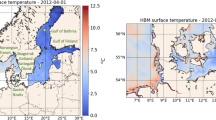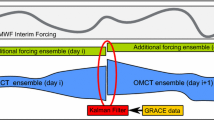Abstract
An implementation of the Ensemble Kalman filter (EnKF) with a coupled ice–ocean model is presented. The model system consists of a dynamic–thermodynamic ice model using the elastic-viscous-plastic (EVP) rheology coupled with the HYbrid Coordinate Ocean Model (HYCOM). The observed variable is ice concentration from passive microwave sensor data (SSM/I). The assimilation of ice concentration has the desired effect of reducing the difference between observations and model. Comparison of the assimilation experiment with a free-run experiment shows that there are large differences, especially in summer. In winter the differences are relatively small, partly because the atmospheric forcing used to run the model depends upon SSM/I data. The assimilation has the strongest impact close to the ice edge, where it ensures a correct location of the ice edge throughout the simulation. An inspection of the model ensemble statistics reveals that the error estimates of the model are too small in winter, partly a result of too low model ice-concentration variance in the central ice pack. It is found that the ensemble covariance between ice concentration and sea-surface temperature in the same grid cell is of the same sign (negative) throughout the year. The ensemble covariance between ice concentration and salinity is more dependent upon the physical mechanisms involved, with ice transport and freeze/melt giving different signs of the covariances. The ice-transport and ice-melt mechanisms also impact the ice-concentration variance and the covariance between ice concentration and ice thickness. The ensemble statistics show a high degree of complexity, which to some extent merits the use of computationally expensive assimilation methods, such as the Ensemble Kalman filter. The present study focuses on the assimilation of ice concentration, but it is understood that assimilation of other datasets, such as sea-surface temperature, would be beneficial.
Similar content being viewed by others
Acknowledgments.
Knut Arild Lisæter is supported by the Norwegian Research Council Ph.D. Fellowship Program, under contract no. 134312/432. Julia Rosanova was supported by the MonArc project, Norwegian Research Council contract no. 127658/720. Geir Evensen was supported by the EC FP-5 TOPAZ project (EVK3-CT2000-00032). This work has also benefited from the support of European Space Agency contracts no. 13971/00/NL/DC and contract no. 14992/01/NL/MM. Further, this work has received support from the Research Council of Norway (Program for Supercomputing) through a grant of computing time. The authors would also like to acknowledge Ola M. Johannessen for valuable input, and the comments of two anonymous reviewers which improved the quality of this work.
Author information
Authors and Affiliations
Corresponding author
Additional information
Responsible Editor: Jin-Song von Storch
Rights and permissions
About this article
Cite this article
Lisæter, K., Rosanova, J. & Evensen, G. Assimilation of ice concentration in a coupled ice–ocean model, using the Ensemble Kalman filter. Ocean Dynamics 53, 368–388 (2003). https://doi.org/10.1007/s10236-003-0049-4
Received:
Accepted:
Issue Date:
DOI: https://doi.org/10.1007/s10236-003-0049-4




